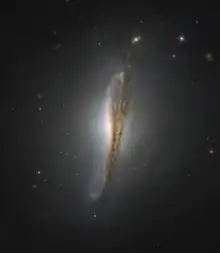NGC 612
NGC 612 is a lenticular galaxy in the constellation of Sculptor located approximately 388 million light-years from Earth. It is a type II Seyfert galaxy and thus has an active galactic nucleus.[1][3] NGC 612 has been identified as an extremely rare example of a non-elliptical radio galaxy, hosting one of the nearest powerful FR-II radio sources.[5][6]
| NGC 612 | |
|---|---|
 Hubble Space Telescope image of NGC 612 | |
| Observation data (J2000 epoch) | |
| Constellation | Sculptor |
| Right ascension | 01h 33m 57.74s[1] |
| Declination | −36° 29′ 35.7″[1] |
| Redshift | 0.02977 ± 0.00010[1] |
| Heliocentric radial velocity | 8925 ± 29 km/s[1] |
| Distance | 388×106 ly (119.33 ± 8.36 Mpc)[1] |
| Apparent magnitude (V) | 13[2] |
| Characteristics | |
| Type | S0 |
| Size | ~122.43 kpc (diameter)[1] |
| Apparent size (V) | 1.5 × 0.9 arcmin[3] |
| Notable features | Rare example of a non-elliptical radio galaxy |
| Other designations | |
| MCG -06-04-046, PGC 5827[4] | |
Observation history
The object was discovered by British astronomer John Herschel on 29 November, 1837.[2] John Louis Emil Dreyer, compiler of the first New General Catalogue of Nebulae and Clusters of Stars, described NGC 612 as a "faint, very small, round, 12th magnitude star to the west."[2]
Physical characteristics

NGC 612 has a fairly well-developed luminous disc seen almost edge-on and features a strong dust ring.[5] The galaxy is surrounded by an enormous disc of cool neutral hydrogen gas with a mass of 1.8×109 M☉ distributed in a 140 kpc wide structure along the galactic disc and dust lane of NGC 612. The majority of the gas is relatively settled in regular rotation with a velocity of 8900 km/s. A faint bridge, spanning 400 kpc, exists between NGC 612 and the gas-rich barred spiral galaxy NGC 619, indicating that an interaction between both galaxies occurred at some point. Current or past interaction, such as a merger event, is currently the most likely trigger of NGC 612's radio source.[6]
The galaxy has an unusually young star population, with populations throughout the galactic disc having an age of ~0.04 - 0.1 Gyr.[6]
NGC 612 is one[7] of 5 (as of 2020) known lenticular galaxies that show large-scale radio emissions. Both spiral galaxies and lenticular galaxies rarely host large scale radio emissions. It is not understood why these type of galaxies are so rare.[8]
See also
- NGC 4151 - another example of a non-elliptical radio galaxy
- List of galaxies
References
- "NGC 612 NASA/IPAC Extragalactic Database Results". ned.ipac.caltech.edu. Retrieved 2018-10-31.
- "New General Catalog Objects: NGC 600 - 649". cseligman.com. Retrieved 2018-10-31.
- "Revised NGC Data for NGC 612". spider.seds.org. Retrieved 2018-10-31.
- "NGC 612". SIMBAD. Centre de données astronomiques de Strasbourg. Retrieved 2021-02-19.
- Véron-Cetty, M. P.; Véron, P. (2001). "Are all radio galaxies genuine ellipticals?". Astronomy & Astrophysics. 375 (3): 791–796. Bibcode:2001A&A...375..791V. doi:10.1051/0004-6361:20010902. ISSN 0004-6361.
- Emonts, B. H. C.; Morganti, R.; Oosterloo, T. A.; Holt, J.; Tadhunter, C. N.; van der Hulst, J. M.; Ojha, R.; Sadler, E. M. (2008). "Enormous disc of cool gas surrounding the nearby powerful radio galaxy NGC 612 (PKS 0131−36)". Monthly Notices of the Royal Astronomical Society. 387 (1): 197–208. arXiv:0805.3371. Bibcode:2008MNRAS.387..197E. doi:10.1111/j.1365-2966.2008.13142.x. ISSN 0035-8711. S2CID 7916786.
- Ekers, R. D.; Goss, W. M.; Kotanyi, C. G.; Skellern, D. J. (1978-10-01). "NGC 612-A Radio Galaxy with a Disk". Astronomy and Astrophysics. 69: L21. ISSN 0004-6361.
- Duchesne, S. W.; Johnston-Hollitt, M. (2019-04-01). "The remnant radio galaxy associated with NGC 1534". Publications of the Astronomical Society of Australia. 36: e016. arXiv:1806.09255. doi:10.1017/pasa.2018.26. ISSN 1323-3580.